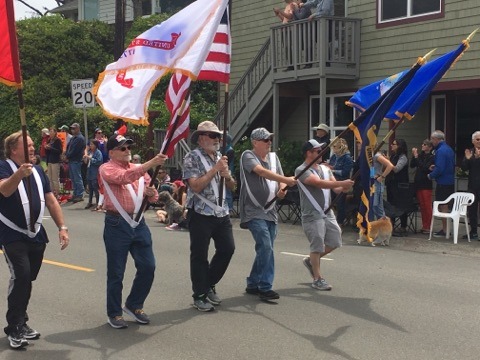EDITOR’S NOTE: Finding common ground – our flag, our freedom and working toward a better community with our flag flying over so many pivotal moments, so many stories to tell. What are your stories of the American flag? Please share with the Pioneer – editor@tillamookcountypioneer.net. See below for a YouTube video of the City of Manzanita’s Virtual 2020 4th of July celebration. Happy Independence Day!

By Dan Haag
I loved my junior high U.S. history class. It was taught by my favorite teacher of all-time, Mr. Wahman. He had a knack for making stories from the past and the people who contributed to them come alive, warts and all. “I want you to be uncomfortable studying history,” he’d often tell us.
He took great pains not to glamorize or varnish history. It pushed me to want to explore it beyond a standardized public school text book.
One day, he asked us about the American flag, gesturing to the corner of the classroom where one hung from a wall bracket.
“What do you see when you look at that flag?” he asked.
It was a complex question, one that tickled the minds of his 12 and 13 year old students. Every morning, we stood at the beginning of announcements, placed a hand over our hearts and recited the Pledge of Allegiance. Perhaps the words meant more to some of us than others. Many of us had grandparents that fought in World War II, others had fathers or uncles who’d served in Vietnam. But it was now 1984 and those events were beginning the slow fade into history. Occupied mainly with kick-ball and Pac-Man, we had nothing that yet qualified as relevant life experience. Nonetheless, we started shouting out answers.
“Freedom,” said one.
“Equality,” said another.
“Gold medals!” one crowed triumphantly. The Olympics had been held in Los Angeles that summer and we had taken great delight in the fact that the Russian team had boycotted the games.
After a smattering of applause at that, Mr. Wahman shared his idea.
“Our flag is a storyboard,” he said. “It tells American’s stories. Each of us has a different American story to tell: good, bad and ugly. You all share these in these stories, even those of people you will never meet.” He gave us another question to ponder. “What do you think others see when they look at it?”
It clicked. He was asking us to look through the eyes of others. What do people see when they look at the American flag? Some of the stories it has told me over the years have helped mold my understanding.
In 2nd grade, I was sharing a joke with a friend during the Pledge of Allegiance. Boys and girls would often shuffle around, flirt, giggle or otherwise misbehave during the Pledge and I was no exception. Our principal, Mr. Schram, strode over me, lifted me off the floor by my shirt collar, pulled me close and bayoneted me with his steely glare. “Pay attention to those words,” he growled before dumping me in a heap onto the floor. I didn’t learn until much later that Mr. Schram was a decorated Marine Corps veteran who’d served in Korea, specifically in the hellish battle at the Chosin Reservoir, where he’d lost friends. To him, the flag meant honoring the sacrifices of others.
The summer before Mr. Wahman’s question, my dad had taught me the proper way to fold the American flag. My first few attempts were clumsy, but after a while it became apparent that this wasn’t just another piece of cloth to be folded and stored haphazardly. “You’re showing respect to others when you fold it this way,” he told me.
As a Boy Scout, I was picked to fold the flag in front of a group of veterans at a Taps ceremony. I was nervous. What if I messed up? The gathered crowd fell silent as I began. Hats were removed, hands placed over hearts. Tears hinted at stories that I would never hear and couldn’t begin to understand. My hands shook but didn’t fail me. As the folds of the flag tightened, I understood the beautiful solemnity of that moment and felt pride at being included. For these veterans of different upbringings and backgrounds, the flag linked them to shared experience and unity.
A few years later, in high school, I was watching our school’s soccer team play a crosstown rival. The referee, a university exchange student from Kenya, made a penalty call against our opponent. The player who was the subject of the yellow card charged the referee and began screaming a vile string of racial epitaphs and violent threats. His teammates cheered him on. At least a dozen parents in the first row of nearby bleachers stood and formed a protective ring around the frightened referee, facing the youth. “Young man, that’s not how we’re supposed to treat people in this country,” one of the parents said calmly. A moment of clarity taking place while our nation’s flag observed from a nearby pole. To these parents – and to the kids like me who saw their actions – it represented standing up for others.
As I revisit that day in Mr. Wahman’s classroom, other stories our flag has witnessed have unfolded before me in a kaleidoscope of wonder, horror, sadness, conviction, and pride: my visit to Arlington National Cemetery in Washington, D.C.; photos of angry white men and women in the south waving the flag as they railed against desegregated schools; images of battered firefighters raising it above the rubble of the World Trade Center; black athletes taking a knee during the national anthem to call out racial inequality; an honor guard of Manzanita veterans proudly bearing it down Laneda Avenue during the 4th of July parade. So many different stories, so many different eyes to study them through.
I don’t know if I’m any wiser now than I was when I last sat in junior high history class. But if Mr. Wahman were here today I would thank him and tell him what I will forever see – and hope that others can see – when looking at our flag: that American storyboard he spoke of.
Today, we are at a moment in our nation’s history where we are re-examining our past and looking for ways to build a better future for all of us as neighbors and citizens. There is no better time than now to start looking through the eyes of others. As it always has been, our story will often be extremely uncomfortable to write. But if we keep our eyes and our hearts wide open, perhaps we can write a better story together.


